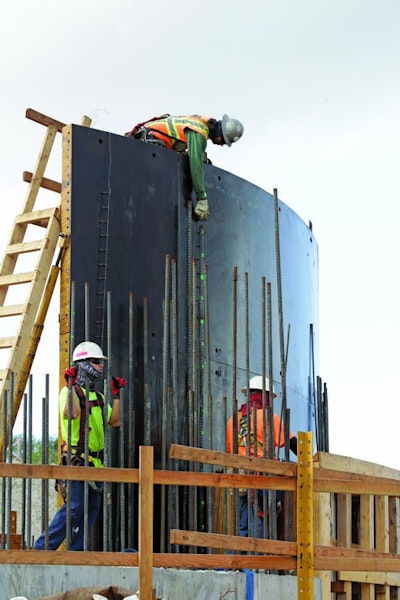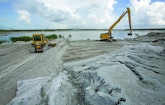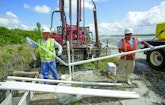
Interested in Infrastructure?
Get Infrastructure articles, news and videos right in your inbox! Sign up now.
Infrastructure + Get AlertsThe South Florida Water Management District (SFWMD) is the largest of five water management districts in Florida, overseeing water resources and providing flood control in 16 counties from Orlando to the Florida Keys. It also happens to be responsible for the restoration of the Everglades, the largest environmental restoration project in American history.
The district relies on both lakes and aquifers to provide raw water. At the headwaters of the Everglades is Lake Okeechobee, the largest freshwater lake in the state. It’s the responsibility of the SFWMD to ensure there is an adequate supply in the regional system – including aquifers, lakes and conservation areas – to satisfy the needs of residents, businesses and the environment. Floodwater is managed through a series of canals and culverts.
The Comprehensive Everglades Restoration Plan has become a district priority, primarily to counteract some of the more harmful effects of development that have significantly reduced the size and also undermined the quality of this unique environment. The program operates in conjunction with the governor’s Restoration Strategies Plan to improve water quality for the Everglades.
“Early developers in this part of Florida simply saw the natural habitat as swampland and the only way to claim that for urban or agricultural use was to dig canals and drain that land,” says Jeff Kivett, division director of Operations, Engineering & Construction with SFWMD.
Droughts and hurricanes
In 1947, the state recovered suddenly from several years of drought – with a deluge averaging 100 inches of rain along the lower east coast, topped off by two hurricanes. The Fort Lauderdale hurricane in September of that year forced a large storm surge over the Herbert Hoover Dike, which was built around Lake Okeechobee by the U.S. Army Corps of Engineers following a 1928 hurricane.
SFWMD’s predecessor, the Central and Southern Florida Flood Control District (CSFFCD), was created in 1949, primarily to reduce such flooding using engineered dams, levees and canals. However, the flood control measures created their own set of problems.
Kivett describes the Everglades as a slow moving river of grass. The water naturally passing over central Florida is known as sheet flow.
“The canals changed the period of flow and the water recession rates,” Kivett says. “Water now moves through the region too quickly and the land dries out too soon. The change in the rate of water flow and phosphorous entering the Everglades from agricultural land replaced the natural sawgrass with competing cattails, changing the natural environment.”
Restoring the Everglades
The SFWMD was established in 1972, evolving from the CSFFCD but given the authority to levy property taxes to fund its activities. The Comprehensive Everglades Restoration Plan was established in 2000 to help reverse the damage to the ecosystem. A host of massive construction projects have been designed to slow down the sheet flow, improve flood control, control runoff and re-establish natural sawgrass – all while maximizing the availability of freshwater and maintaining the current water distribution system.
The district currently manages about 2,000 miles of canals, more than 2,800 miles of levees and berms, 69 pump stations, 645 water control structures and more than 700 culverts.
“A lot of that infrastructure dates back to a period ranging from the 1940s to the 1970s,” Kivett says.
Much of the distribution system is made up of natural earth canals, concrete-lined canals and corrugated metal pipe culverts as wide as 15 feet and up to 25 feet tall.
“Some of our larger pipes are concrete that range in size up to 12- by 12-foot box culverts,” Kivett says. “We generally talk about moving acre-feet of water, but the typical pipe structure has a capacity to move anywhere from 1,000 to 4,000 cubic feet per second of water through our system.”
The most frequent maintenance effort is concentrated on the metal grates that prevent access to the culverts. They’re sandblasted and recoated every 10 to 12 years.
Steel culverts are also routinely replaced, offering a shelf life of 20 to 30 years.
“We conducted a study of the average service life of the steel culverts and found that stainless steel was performing far better than regular steel,” Kivett says. “We’re now doing all of our replacements with stainless.”
Another more unusual maintenance concern – mowing the grass on the levees.
Canal system is evolving
The district is managing a $50 million capital improvement program to replace older structures and upgrade pump stations. However, it’s the canal system itself that’s currently facing the most exacting scrutiny.
“People have begun to realize that the canals themselves represent an environmental issue and must be balanced against the need to restore the Everglades ecosystem,” Kivett says. “Some of those canals, for example those going through downtown Miami and West Palm Beach, are going through rehabilitation – dredging and cleaning so they can function to the specifications for which they were originally designed. However, other canals, particularly the ones carrying water from Lake Okeechobee through wetlands, are being replaced with large reservoirs.”
The reservoirs are essential to the district water supply. Although this area of the state is blessed with 50 to 60 inches of rainfall per year, the district still must promote conservation to balance supplies with the needs of citizens, businesses and agriculture – particularly during dry periods.
“We can have an early wet season and a damaging release of water and in a few weeks go from way too much water to managing a drought,” Kivett says. “That’s one of the biggest challenges of the district.”
The largest current storage project is the L-8 Flow Equalization Basin in Loxahatchee, about 20 miles west of West Palm Beach, one of six similar projects planned for the district. The facility is a conversion of a 950-acre open pit limestone rock mine purchased by the state in 2007 for about $220 million and augmented with $64 million in additional infrastructure.
“Once the state purchased the site, we asked the miners to go deeper, from an average of about 40 feet to about 53 feet, by removing additional materials,” Kivett says. “There are multiple canals that will feed into it, and the basin will be divided into seven storage cells and associated control structures capable of managing 15 billion gallons of water.”
Storing water in limestone
The limestone rock pit provides a naturally secure basin for the storage of water, demonstrating very low rates of seepage. Construction work by Archer Western Contractors includes creation of an inlet structure and outflow pump station. Additional work at the facility is designed to minimize erosion around the edges of the basin. This includes cement lining for the levee surrounding the facility, a foot of soil cement – rock mixed with cement – and a 20- to 30-foot-wide rock layer.
The equalization basin will be able to accept an inflow of up to 3,000 cfs of stormwater and will be pumped out at a rate of up to 450 cfs.
“The engineers at Jacobs Engineering Group Inc. designed a two-stage pumping system,” Kivett says. “If the reservoir is at the high stage, we can use a less powerful pump to remove the water. A second, more powerful pump will be used on water that needs to be pumped out when levels have dropped down significantly.”
The basin has already been used to the district’s advantage. In 2012, approximately 3.1 billion gallons of water were directed to the basin during Tropical Storm Isaac. The City of West Palm Beach also used more than 600 million gallons of water from the basin to supplement its water supply during the drought of 2007.
“Once the facility goes fully online, we can preserve freshwater that was once let out to tide and then reconnect some of the historical flow paths of the Everglades,” Kivett says. “We can also moderate the flow of water into the various marshes – stormwater treatment areas – and then ensure that we maintain some of the historically natural flow to them during dry periods.”
The L-8 basin is scheduled to be completed in December 2016, but the restoration of the Everglades is a much longer-term project.
“We’re already achieving success for our efforts,” Kivett says. “The rate of deterioration of the Everglades ecosystem has been greatly slowed down and we’re seeing a much healthier system.”













